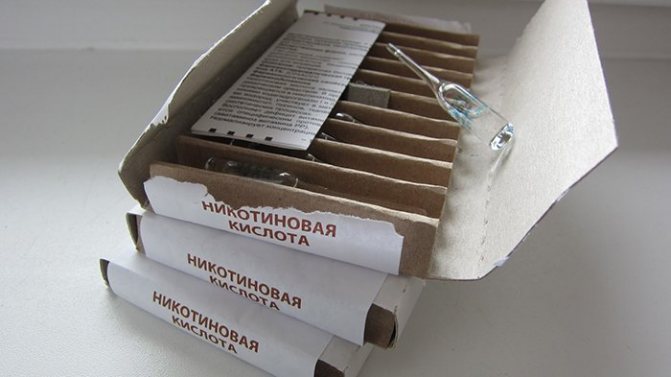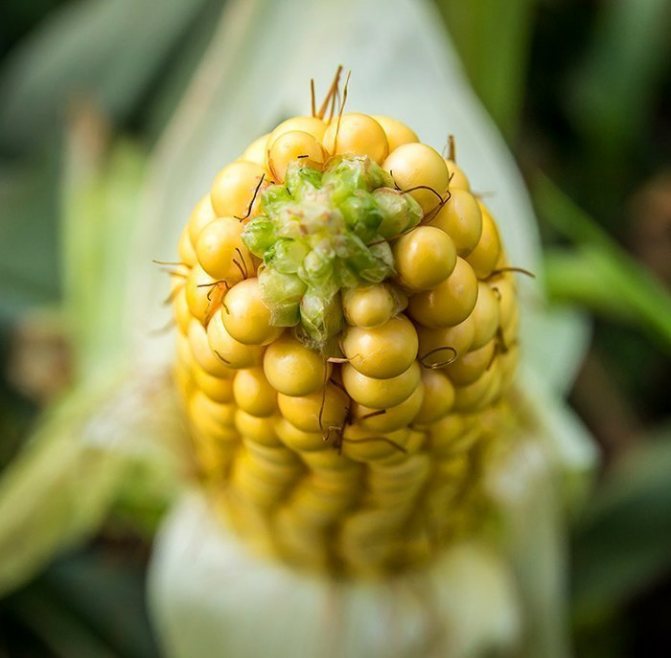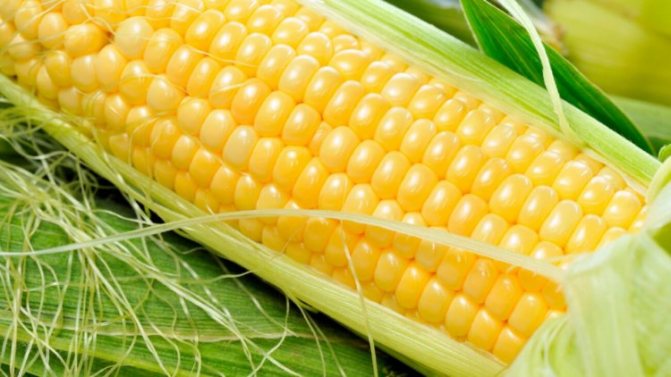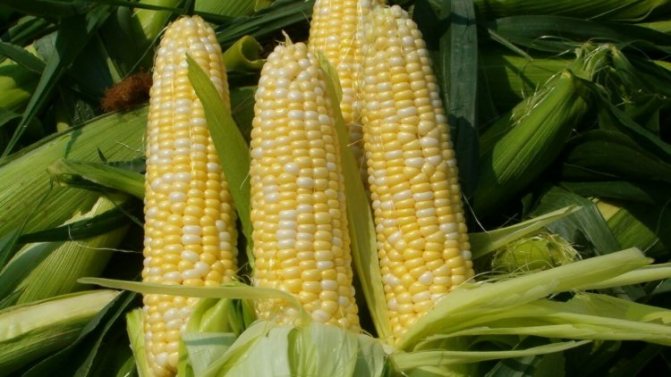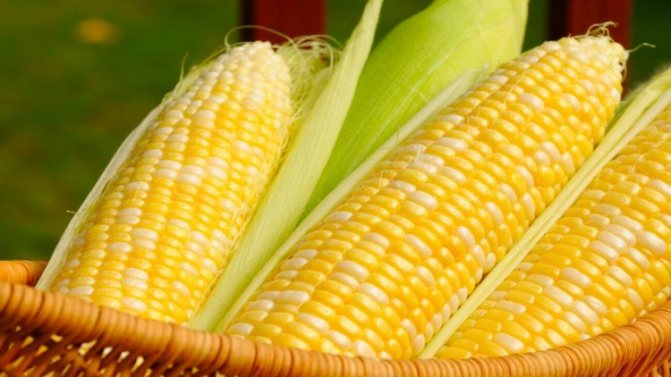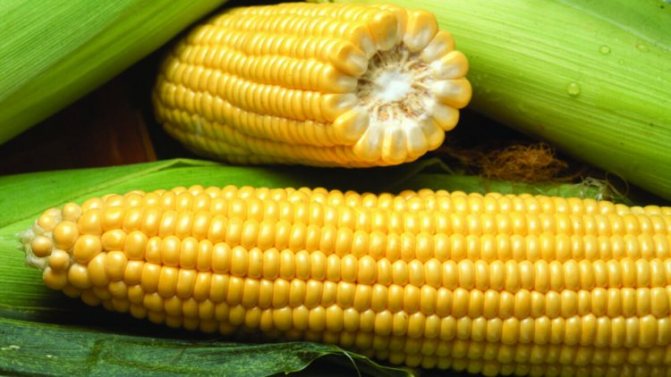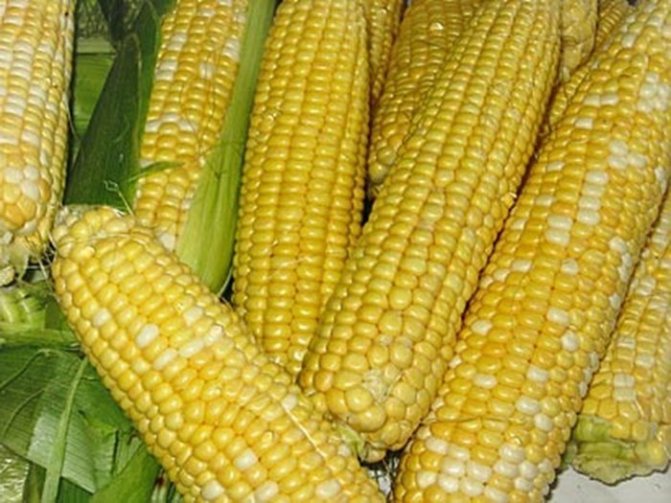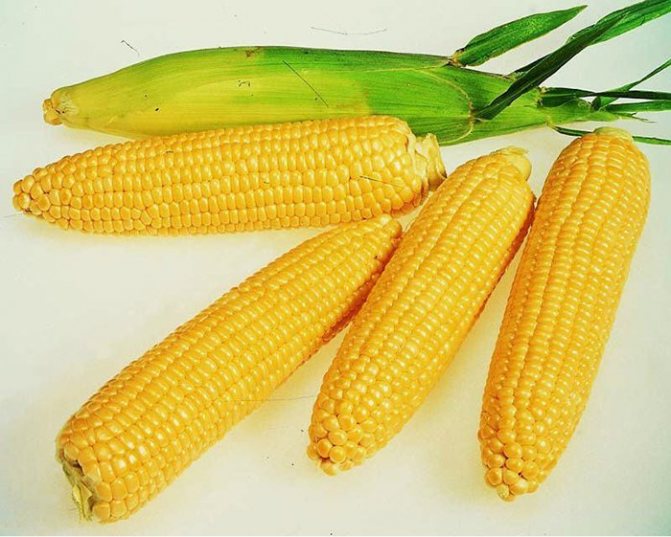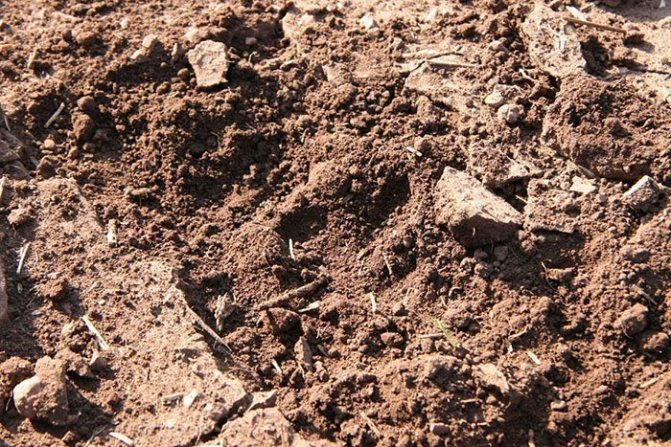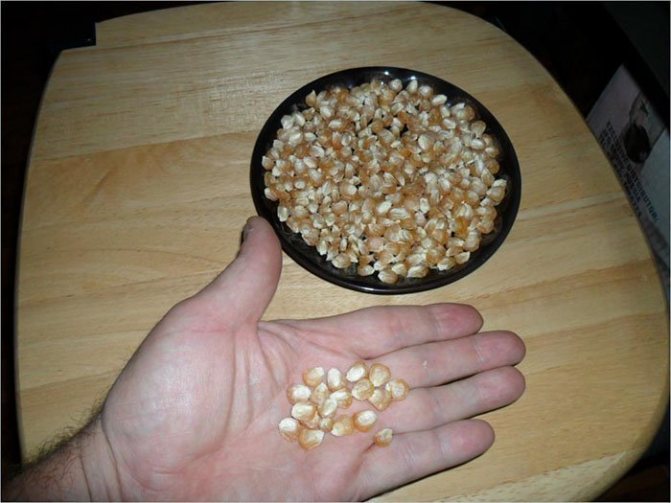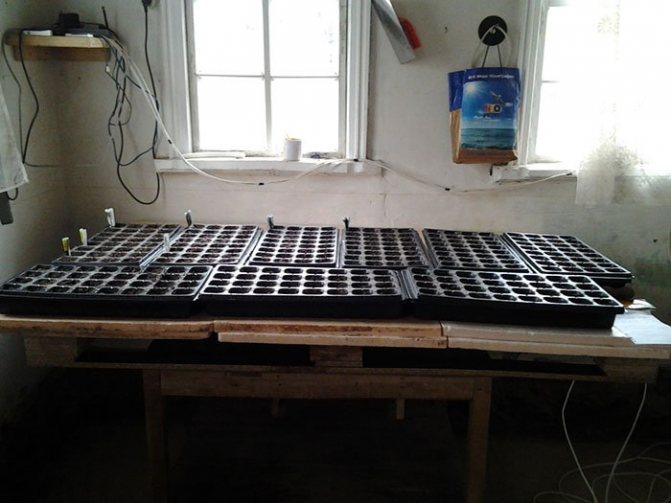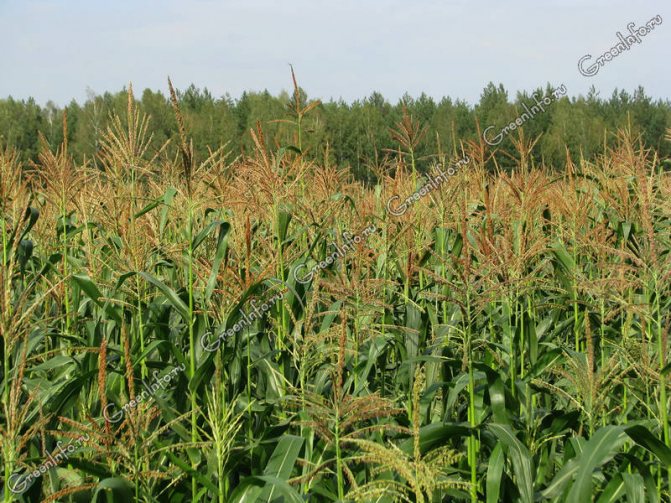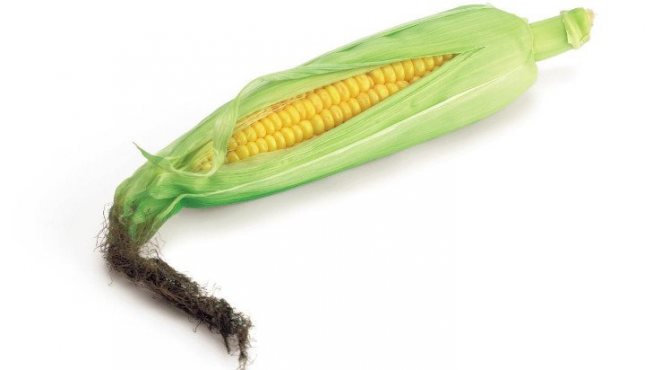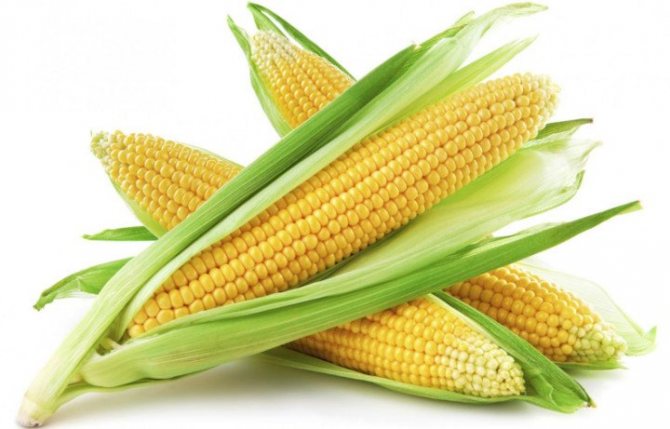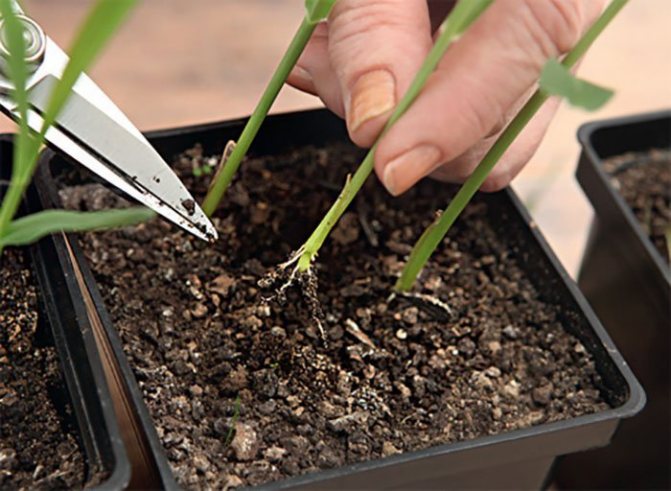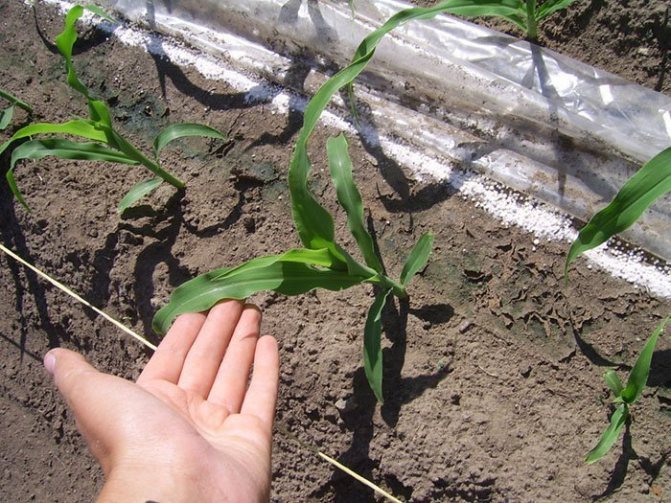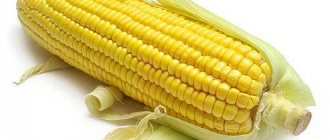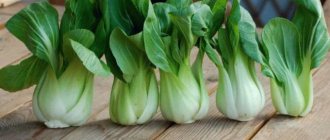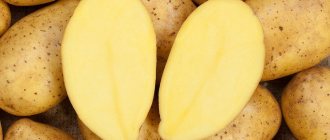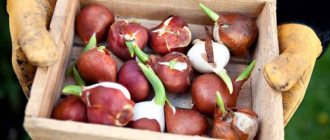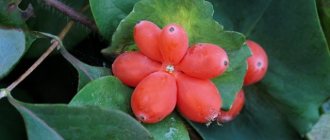Author rating
The author of the article
Yakov Pavlovich
Professor, Head of the Department of Vegetable Growing
Articles written
153
Corn as a vegetable crop is divided into grain and sweet (sugar). Grain varieties are used for the production of corn flour and cereals, alcohol, fodder (feed for livestock). Sweet corn is a popular vegetable to be consumed fresh, boiled or baked, as well as frozen and preserved. A special variety (other than sweet, bursting) is used to make popcorn. In connection with the success of breeding and the emergence of ultra-early hybrids, the popularity of sweet corn is growing among gardeners of the Central strip, the Urals and Siberia.
Biological features
It is sweet corn, a tall (up to 3 m) annual herbaceous subtropical plant with a well-developed root system. The stem of this plant can be up to 7 cm in diameter. The female flowers of sweet corn are collected on the cob, the male flowers are gathered in panicles. The fruit is a reniform or round caryopsis. It may have a different color, depending on the variety. The most commonly grown varieties are with yellow ears.
It differs from fodder sweet corn in more delicate leaves and lower height. The ears develop faster on it. Flowering can begin when the plants reach a height of 20-25 cm.

Biochemical composition of sweet corn seeds
Sweet corn is considered to be a vegetable crop, unlike other fodder representatives of this family. Sugar maize seeds in terms of the content of a complex of minerals and vitamins, taste and nutritional qualities, occupy a leading position among other vegetables. The grain of milk-wax maturity on average contains dry matter - 31.2%, carbohydrates - 24%, dextrins - 10%, as well as protein - 3.7%. The protein contains acids essential for the human body - lysine and tryptophan.
In addition, the grain contains vitamins such as B6, PP, B1, B2, B3, C, K, pantothenic and niacin, biotin and choline. Yellow grain varieties are capable of storing vitamin E and carotene. In terms of nutritional value, sweet corn grains are not inferior to beans and a green pot: it contains 4% proteins, 12-14% starch, 5-8% sugars, 1.2% fats. Sugar maize seeds differ from fodder ones with a wrinkled and glassy structure, which is caused by an increased content of polysaccharides and sugar.
Growing benefits
Above was given a detailed description of sweet corn. The plant is thus tall, with a developed root system. Of course, in the Russian climate, in order to get a good harvest, this subtropical crop will need to pay some attention. However, the time spent will certainly be rewarded a hundredfold. Among the most beneficial for the health of agricultural crops, corn occupies one of the first places. Its fruits contain a third of all trace elements necessary for a person. Also, corn kernels are rich in all kinds of vitamins and other useful substances. They contain the fruits of this plant and a large amount of sugars. Hence the name of the group.
Benefits
The obvious advantage in growing sweet corn is its nutritional value.Juicy, sweet grains are exactly what the human body needs at any time of the year. And the overall nutritional value is an order of magnitude higher than that of other varieties of corn, which makes it more beneficial in terms of consumption. The accumulation of sugar also distinguishes it favorably.
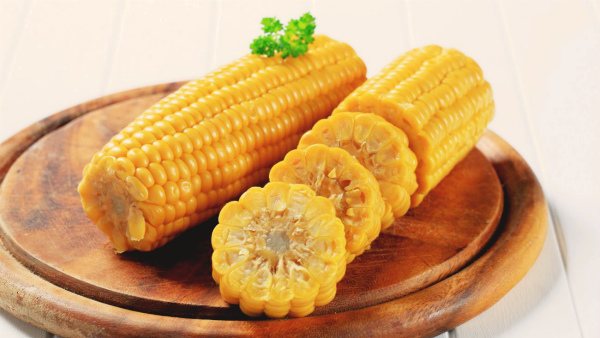

You can eat both fresh cobs and cooked ones: boiled, baked, frozen, canned. As a useful nutritional ingredient, sugar corn is simply irreplaceable.
Most of the sweet corn varieties are hybrids. This means that they have increased resistance to a variety of diseases, both fungal and bacterial. In addition, they are less whimsical to the type of soil, which allows cultivation on any site.
Most popular varieties
Of course, a gardener who decides to start growing this wonderful unpretentious crop, first of all, should attend to the purchase of seed. There are many varieties of sweet corn. In the conditions of Russia, in most cases, early maturing varieties are grown. Ordinary corn in our climate simply does not have time to ripen. The most popular varieties among Russian gardeners are:
- Kuban sugar;
- Spirit F1;
- Gourmet;
- Dobrynya.
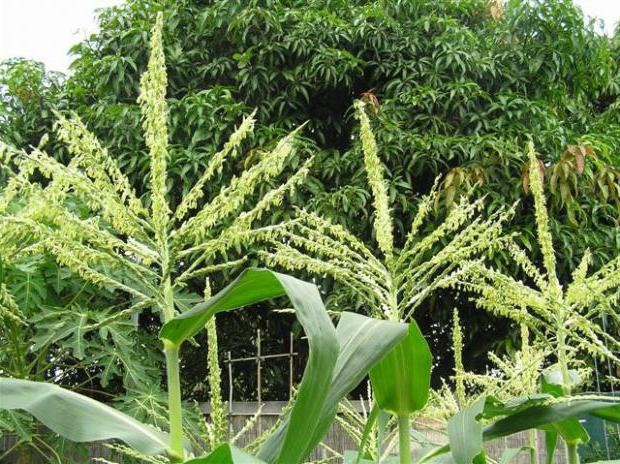

Starchy corn
Mainly cultivated in South America and southern North America. The plants are tall (over 2 m) and produce long cobs (about 30 cm) with a thin head of cabbage. The grains have a convex top, a smooth matte surface and a rounded shape. Endosperm is characterized by a high starch content, friability and powdery. The grain contains about 12% protein, 5% fat and more than 80% starch, therefore it is mainly used to obtain alcohol and starch.
Starchy corn is poorly preserved after harvest and is often subject to various diseases, since it is practically devoid of an outer shell.
Famous varieties in this category:
- Mays Concho... It belongs to the early maturing varieties and has an ancient history, since it was grown by the Indians from North America. Shoots grow up to 2 m, and cobs - from 20 to 35 cm. The grains are golden brown, soft to the touch, large and slightly rounded. Corn is suitable for boiling and processing into flour.
- Thompson Prolific... A late-ripening high-yielding variety that is very popular in America, where it is grown on almost all farms. The plant grows to a gigantic size - up to 3.2 m high. On it, cobs of 2-4 pieces are tied, up to 42 cm long and in the shape of a cylinder. The grains are large (2 times larger than those of other varieties), flattened and white. This corn is boiled, even fried. In industry, high quality flour and feed for cattle and poultry are obtained from it.
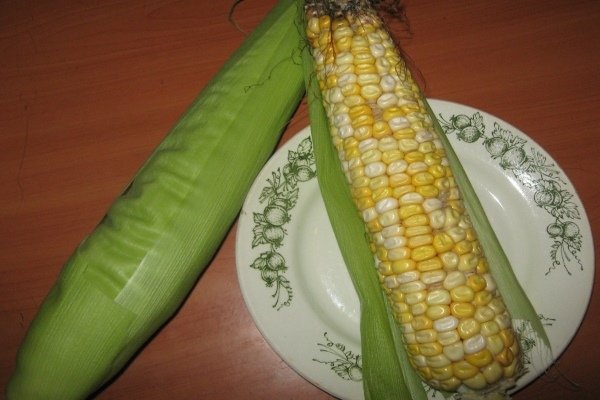

grade Mays Concho
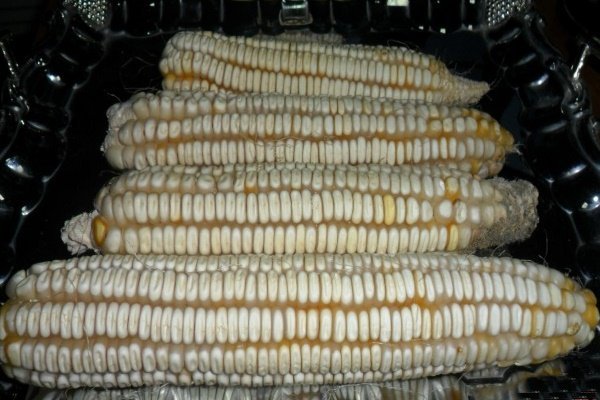

Thompson Prolific cultivar
Dobrynya corn
The advantages of this variety include, first of all, the very large size of the cobs. An early hybrid Dobrynya can grow up to 170 cm in height. You can choose this variety for growing, including those summer residents, whose land on the site is not very good. The Dobrynya hybrid is completely undemanding to the composition of the soil. Also, this early sweet corn is not at all afraid of such common diseases as mosaic and rust. The ears of this variety ripen on the 70th day after planting. Unlike many other hybrids, they can be harvested not only in the phase of milk maturity, but also dried up.
The sweetest varieties and hybrids of sweet corn to grow from seeds
There are a large number of varieties of sweet corn, but the most popular, which take root well in Ukraine, Russia, Belarus, are several.
Bonduelle
When talking about sweet corn varieties, many consumers think of Bonduelle, a delicious, nutritious, sugary vegetable.However, not everyone knows that this name is the name of a company that produces canned corn, and not one of the crop varieties. The central capacities of the Bonduelle-Kuban brand are concentrated in the Krasnodar Territory, in the Russian Federation. For the canned food that consumers love, the company uses Spirit and Bonus corn varieties, which are grown in the southern regions of the state.


Dobrynya
Dobrynya is a hybrid member of early varieties, which is able to please with a harvest already 2.5 months after sowing. The plant is of medium height, reaches a height of 1.7 m, while the heads of cabbage begin to form at a height of 70 cm. Dobrynya fruits are large, juicy, consist of 16-18 rows of seeds, have an increased percentage of sucrose. The cobs perfectly tolerate freezing and do not lose their nutritional value. The plant is distinguished by unpretentious cultivation, high resistance to diseases, the ability to grow and bear fruit on almost any soil.
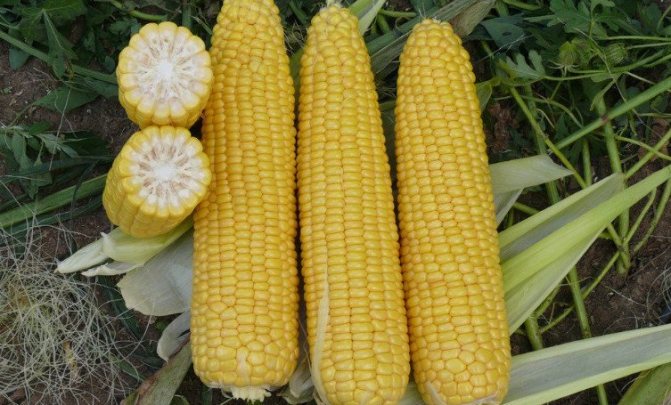

Gourmet
Gourmet is an early variety, the ripening period of which varies from 70 to 75 days. The main advantages of the variety are excellent resistance to diseases and parasites, as well as high yield. The plant grows up to 1.8 m, and forms large cylindrical fruits 22 cm long, consisting of 18-22 rows of grains. The fruit weighs 180–50 g. They taste sweet and very juicy. Maize of this variety is harvested during its milky ripeness. Used for canning, freezing, cooking various dishes.
Video: corn gourmet
Megaton F1
Megaton F1 is a super-sweet variety with a mid-ripening period of 85–95 days. The plant has an impressive height, cobs up to 25 cm long ripen on the stem. The fruits are golden in color, very sweet and delicate in taste. The advantages of Megaton are its high yield, unpretentiousness in cultivation, resistance to such ailments as corn mosaic, helminthosporium, fusarium. It is used as a product for the fresh market or preservation.
Video: corn megaton f1
Morning song F1
Morning Song F1 - an early ripe, unpretentious hybrid in cultivation, which pleases with the first fruits in 70–74 days. The culture can reach a height of up to 1.5 m. The ears are cylindrical in shape, long - about 17 cm, weighing 190-210 g, consist of 12-14 rows of grains. The grains are characterized by excellent taste, have a juicy, soft and delicate structure. This variety is recommended for preserves or for boiled consumption.


Arkon F1
Arkon F1 is an ultra-hybrid variety of super sweet corn, the main advantage of which is its high resistance to weather conditions, which is very important for early spring planting. The culture ripens early, 68–70 days after planting. In the process of growth on a stem with a height of 1.7–1.8 m, two full-fledged ears ripen with high-quality agricultural technology. The fruits are 22–25 cm long, densely covered with a layer of dark green, elastic leaves. Arkona grains are used fresh or as raw materials for the production of canned blanks.
Video: corn arkon F1
Early golden
Early golden - early ripening plant. The first fruits can be harvested within 85–90 days after sowing. The hybrid is characterized by low vigor and excellent resistance to fungal diseases. On a low stem, compact small cobs are formed about 19 cm long and weighing 200 g. The fruits are distinguished by pleasant taste properties: rich golden color, juicy, sweet grains with a soft, melting consistency. The ears of the crop are ideal for conservation. Can be used for freezing.
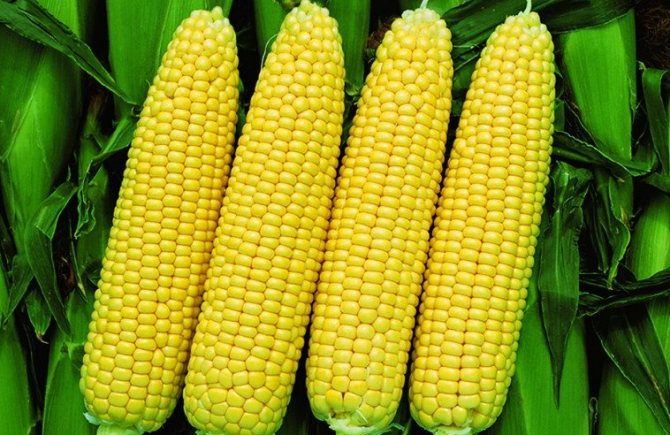

Vega F1
Vega is a super-sweet, early ripe representative of Ukrainian selection.The growing season of the plant is 70–75 days. During ripening, two full-fledged fruits of medium size are formed on the stem - 22–25 cm, with 18–20 rows of grains. The ears are characterized by a high sugar content and a pleasant, sugary, delicate taste. Among the main advantages of the hybrid are: fast ripening time, high yield, low cost and ease of growing. In most cases, Vega is sold fresh on the market. However, it lends itself well to freezing and is suitable for making preserves.
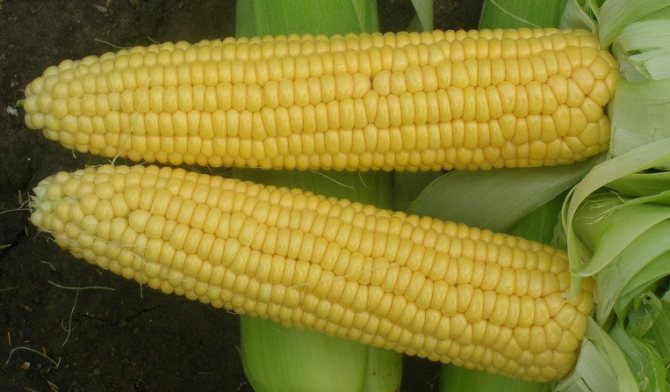

Baron F1
The Baron belongs to super early, super sweet hybrids that ripen 61–67 days after planting. The culture has a strong, sturdy stem 1.8–1.9 m high, on which two well-formed ears 20–22 cm long and 300–350 g weight grow. The hybrid is super sweet, with an average sugar content of 15–16%.
The fruits of the plant are large, dense, with grains of a dark yellow color, which is considered a distinctive feature of the variety. Baron is resistant to lodging, high resistance to viral and fungal diseases. The fruits are used fresh for freezing or conservation.
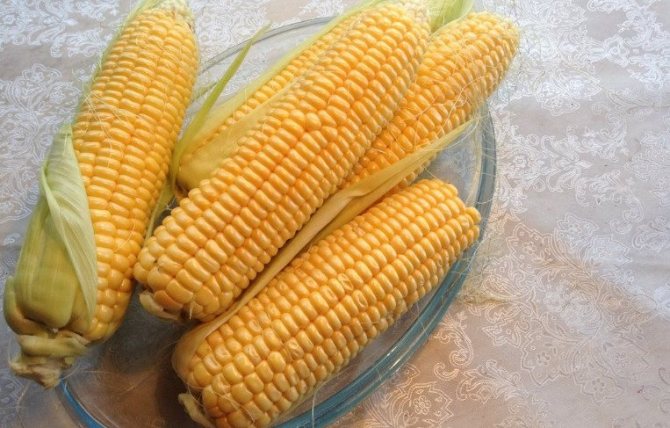

Spirit
Spirit is a mid-season variety that is distinguished by the presence of tender, juicy and very sweet fruits. Heads of cabbage ripen 90–100 days after planting. The main advantage of Spirit is the high content of polysaccharides in the grains. The plant can reach a height of 2.1 m, the size of the fruit is 22 cm. The grains of corn are large, juicy, fleshy in structure, extremely sweet, soft, have a golden color. The hybrid is highly resistant to viral and fungal diseases, as well as rot. It is used boiled or for canning.
Video: corn spirit
Ice nectar
Ice nectar is one of the sweetest varieties. It belongs to plants with a late ripening period, which give the first fruits after 130-140 days. The height of the culture reaches 1.8 m, and the length of the heads of cabbage is 20–25 cm. The taste of the fruits is sweet, juicy, and delicate in consistency.
Important! To preserve the sugar content of the fruit, experts advise planting Ice Nectar away from other varieties in order to avoid cross-pollination.
Surprisingly, due to the high content of polysaccharides in the grains, they are allowed to be consumed raw. Corn of this variety tops the ranking of varieties in terms of yield.
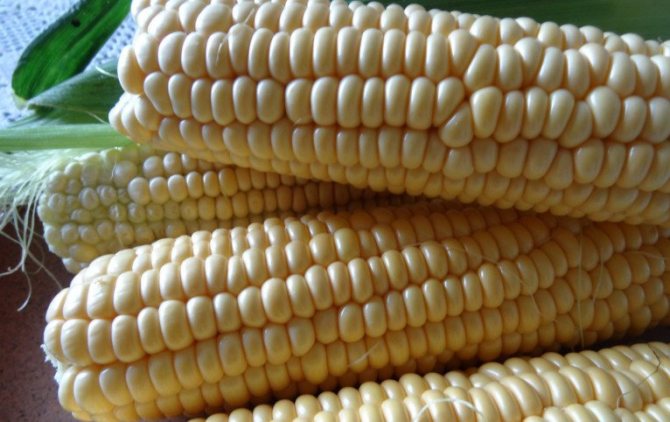

Sundance
Sundance is a low-growing variety that begins to ripen 70–90 days after planting. Each bush grows up to two heads of cabbage, no more than 20 cm long and 5.5 cm in diameter. The fruits of the plant are heads of cabbage, with bright yellow elongated grains, which have a pleasant, sugar taste.
Did you know? Sweet corn is really sweet corn only when fresh. Already 6 hours after collecting it, it loses the percentage of sweetness by almost half, since sugar is converted into starch.
This type of corn is used for the preparation of canned food or for cooking.
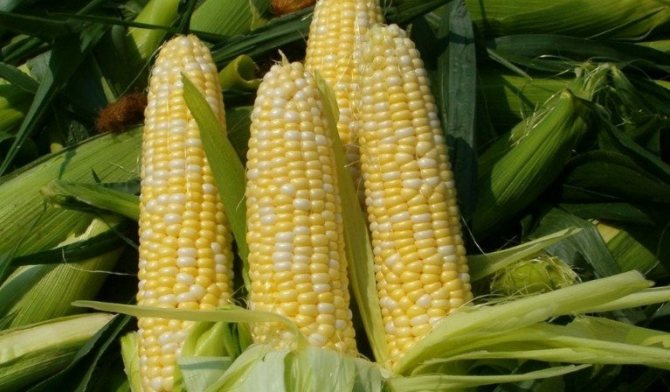

Seed preparation
So, the variety of sweet corn has been selected, and the planting material has been purchased. Next, you need to start preparing the seeds. In principle, they can simply be planted immediately in the ground. However, the prepared material will rise faster, and the corn itself will grow much healthier and more productive in the future. The pre-sowing preparatory measures are as follows:
- The seeds are laid out on a sheet of paper in an even layer and placed in a sunny place for 5 days.
- The heated material is soaked for a day in a warm solution of potassium permanganate (weak) or a growth stimulator.
Seeds prepared in this way will sprout several days faster.
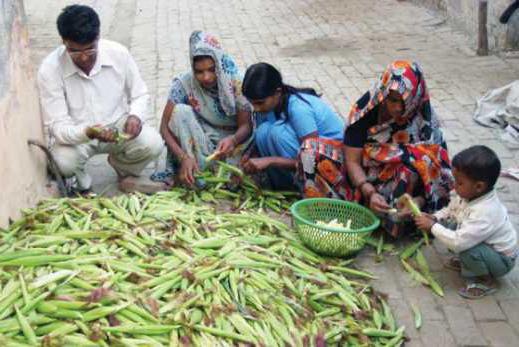

Seed preparation
The number of seeds for planting is calculated based on the consumption rate: about 200 g of seeds per 1 hectare of land. Presowing seed preparation consists of the following stages:
- Checking seeds for germination.The grains should be immersed in a saline solution (95 ml. Water and 5 g of salt): only those grains that will sink to the bottom will be suitable for planting;
- Treatment of grains with substances that prevent the development of bacterial and fungal infections: a slightly pink solution of potassium permanganate (potassium permanganate) or 3% hydrogen peroxide, where the grains are placed for 5 minutes.
Where to plant?
A good crop of corn can only be harvested if it gets enough sunlight during the season. Therefore, it is worth placing this plant either on the south or southwest side of the house, or on a flat area, provided there are no large trees nearby. It is very good if there is some kind of obstacle (building, bushes, etc.) on the side from which the prevailing winds blow in a given area. Sweet corn is a tall plant, and the wind can simply break it or "roll it up".
In most cases, summer residents place corn along the fences or next to the terrace. If desired, this culture can be used as an element of landscape design. For example, it is easy to make a temporary hedge out of it when zoning a site.
Tooth corn
It is the most popular throughout Russia. It can be grown in suburban areas for cooking or freezing. In industry, cereals, flour, alcohol and even silage for cattle are made from grains.
This type of corn is distinguished by its large grains, which are flat and slightly elongated. In the center of the grain and at its top, the consistency of the endosperm is loose and mealy. When the grain ripens, a depression appears on the top of the grain. It contains up to 75% starch, up to 5% vegetable fat and up to 10% proteins, is distinguished by high vitreousness and minimal powdery content.
Plants grow tall - about 2 m long, do not really bush and give an excellent yield - 150 c / ha when planted in early spring. It should be noted that many varieties in this category are medium late crops.
Here are the most popular representatives:
- Ruby Garnet... Medium late variety of Russian breeders. It grows up to 2.4 m. Cobs are cylindrical, large and long (about 30 cm). The grains are large in size and somewhat resemble horse teeth. They have a ruby reddish color. In industry, flour and cereals are produced from such corn.
- Red corn... Refers to medium late plants - the growing season lasts 90-100 days. This variety is very useful for the prevention of cardiovascular and oncological diseases, and also normalizes blood pressure and sugar levels, therefore it is especially useful for diabetes mellitus.
- Indian giant... A late-ripening variety that grows in India. The growing season lasts up to 125 days. Corn is called "giant" for a reason, as it grows up to 2.7 m and gives 3-4 ears. They grow up to 40 cm and are cylindrical. The grains are large, flat and have a wide variety of color shades (white, yellow, orange, purple, lilac, black). The variety is excellent for boiled consumption as it contains more than 30% sugar. In production, it is processed into cereals, flour, fodder for poultry and animals.
- Blue Jade... The mid-late variety was developed in North America. It ripens 4 months after planting. The plant grows up to 2.4 m. The ears are about 17 cm long, round-pyramidal in shape. Large and flat grains are pink-blue, covered with small white specks. Boiled corn is very tasty and unusual. It has a preventive effect against serious diseases (cardiovascular, oncological, diabetes mellitus), since it contains a large amount of anthocyanin.


Ruby pomegranate variety
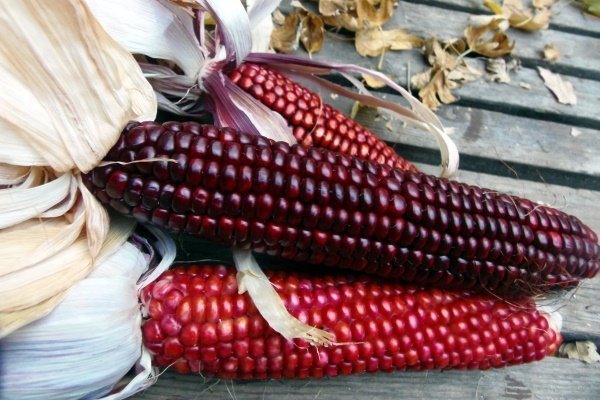

Red corn variety
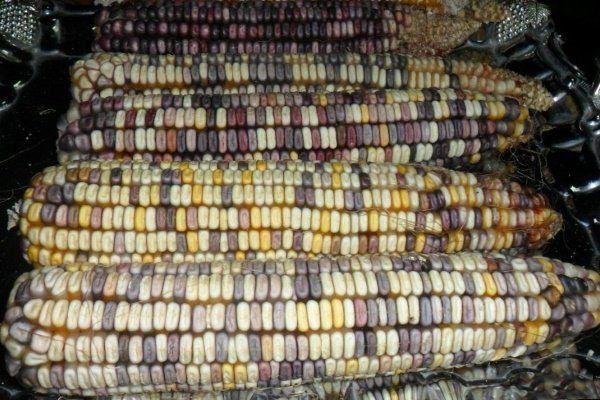

variety Indian giant
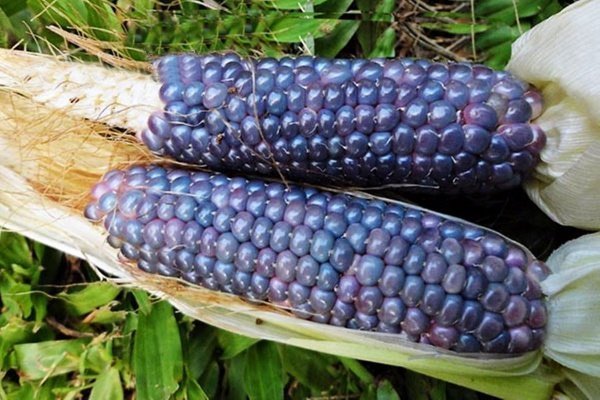

grade Blue Jade
Best predecessors
Sweet corn can be planted after almost any other garden crop that has been fertilized. The best precursors for this plant are potatoes, cabbage and peas. It is not recommended to sow this crop after millet. The fact is that these plants can be affected by the same pest - the corn moth. It is also not recommended to plant this crop after or next to beets.
Very often, corn is placed next to cucumbers and the latter are whipped along its stems and branches. You can plant this plant next to the pumpkin. However, corn stalks should not be adapted to the lashes of this crop. The pumpkin is too heavy.
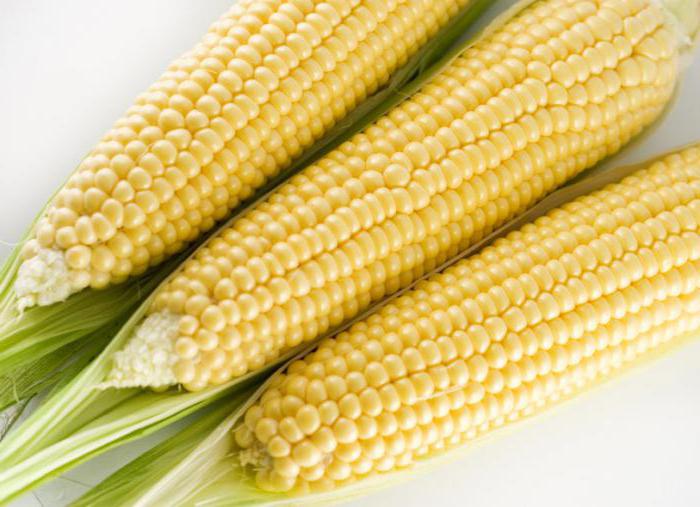

Landing
Corn prefers fertile, loose soil with a high oxygen content and low acidity. Most sweet varieties need a moderate amount of moisture, but in this case a little more is better than less. In the fall, after the previous crop has already been removed from the garden, or in the spring, shortly before planting, it is necessary to plow the area deeply, fertilize well with mineral and organic fertilizers.
Before planting, you need to prepare the seeds so that they germinate well. For 5-6 days before planting, they need to be soaked in a solution of potassium permanganate for 8-10 hours. Also, you can subject the seeds to hydrothermal treatment: heat the water to 50 degrees, place the grains in it for 1-2 minutes, then transfer to cold, then again to hot water, alternating for 20 minutes.
Be sure to check the seeds for germination by placing them in a strong saline solution for 10-15 minutes. Throw away those that come up without regrets - they will not give a good harvest. But those that have settled at the bottom must be rinsed under running water and dried before planting.
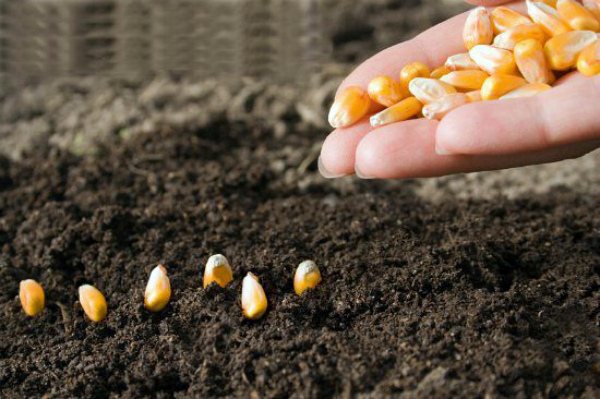

For sweet varieties, the best time to plant is mid-May. Why? The soil temperature has already reached the desired 12-13 degrees Celsius, which means the seeds will quickly grow.
Mark out holes in the garden bed, measuring 30 by 60 centimeters, moisten them and place the seeds 5-6 centimeters deep, and then water again. Place 2-3 grains in each hole to ensure the best germination. If all the shoots hatch, then simply remove the weakest ones from the garden.
A big plus of sweet varieties is that cultivation is possible for several years in the same place, that is, there are no harsh rules for traditional crop rotation, when the crop must be transplanted to a new place every year.
What should be the soil
One of the features of corn is its undemandingness to the composition of the soil. This plant will feel good both on podzolic soil and on black earth or even peat. However, it is best to plant this crop in light, well-permeable soil with water and air, with an acidity of 6-7 pH. The area dug up for corn should be as deep as possible. After all, the roots of this plant are capable of going down 1.5-2 m.
Before planting in the furrow, it is advisable to apply organic fertilizers (rotted manure, humus) and some kind of phosphorus mineral fertilizing (for example, superphosphate at the rate of 10 g / m2).
Features of sweet corn and differences from other types
Sweet corn is an annual herb, reaching a height of 3 m. It has a stem of medium thickness, up to 8 cm in diameter. The flowers of the female type are collected on the cob, and the flowers of the male type resemble fluffy panicles.


The color of the grains varies from light yellow to golden, depending on the variety. Corn cobs are very sweet, high in sucrose and low in starch. They are used boiled, raw, and canned.
In addition to sugar varieties, such types are widespread as:
- Bursting... It differs from sugar in its high content of protein, fat and starch.It is used for the production of popcorn, cereals, flakes. The culture forms a large number of cobs with small grains in a dense shell.
- Tooth-shaped... It is cultivated to obtain grain from which flour, cereals, alcohol and feed for agricultural animals are produced. All varieties of dent corn are classified as mid to late maturing. In the process of ripening, a small depression forms in the grains, which is why the plant got its name.
- Siliceous... The crop is grown for flour, cereals, corn sticks and flakes. Convex grains have a shiny and dense shell. The ears are rich in starch and protein.
- Stern... The culture is grown specifically to obtain green mass, which is used as feed for animals and birds. Silage, meal, starch, alcohol, gluten, oil are prepared from fodder varieties. The grains are quite hard and tasteless, nevertheless they are good for food.
Interesting fact. Corn cobs have lost half of their sweetness within six hours after picking.
In the photo, sweet corn of the White Cloud variety.
Structure
Raw sweet corn chemical composition table.
| Name | Content | Norm |
| Vitamin A | 9 μg | 900 mcg |
| Beta carotene | 0.047 mg | 5 mg |
| Vitamin B1 | 0.155 ml | 1,5 mg |
| Vitamin B2 | 0.055 mg | 1.8 mg |
| Vitamin B4 | 23 mg | 500 mg |
| Vitamin B5 | 0.717 mg | 5 mg |
| Vitamin B6 | 0.093 mg | 2 mg |
| Vitamin B9 | 42 μg | 400 mcg |
| Vitamin C | 6.8 mg | 90 mg |
| Vitamin K | 0.3 μg | 120 mcg |
| Vitamin PP | 1.77 mg | 20 mg |
| Potassium, | 270 mg | 2500 mg |
| Calcium | 2 mg | 1000 mg |
| Magnesium | 37 mg | 400 mg |
| Sodium | 15 mg | 1300 mg |
| Phosphorus | 89 mg | 800 mg |
| Iron | 0.52 mg | 18 mg |
| Manganese | 0.163 mg | 2 mg |
| Copper | 54 μg | 1000 mcg |
| Selenium | 0.6 μg | 55 mcg |
| Zinc | 0.46 mg | 12 mg |
KBZHU
Nutritional value of the product per 100 g:
- calorie content - 86 kcal;
- proteins - 3.27 g;
- fats - 1.35 g;
- carbohydrates - 16.7 g;
- fiber - 2 g;
- water - 76.05 g;
- ash - 0.62 g;
- starch - 5.7 g;
- water-soluble saccharides - 6.26 g;
- glucose - 3.43 g;
- fructose - 1.94 g;
- sucrose - 0.89 g
Corn cobs are rich in essential and essential amino acids, saturated and unsaturated fatty acids.
Benefit and harm
Regular consumption of sweet corn brings tangible benefits to the body, which is manifested in:
- normalization of metabolism;
- elimination of excess cholesterol;
- lowering blood glucose levels;
- strengthening immunity;
- normalization of hormonal levels;
- reducing the risk of heart attacks, strokes and cancer;
- normalization of water and electrolyte balance;
- strengthening bone and muscle tissue;
- increased hemoglobin levels;
- general rejuvenation of the body;
- improving intestinal motility;
- cleansing blood vessels;
- elimination of biliary stasis.
reference... Corn cobs do not accumulate chemicals that are used to treat fields. Therefore, they can be consumed even raw.
Doctors advise not to get carried away with corn for people suffering from stomach diseases and obesity.
In the first months of breastfeeding, corn should be avoided, since the product can provoke colic and excessive gas production in the baby.
How to sow
They start planting corn in mid-early May, that is, at a time when the soil warms up to a temperature of at least 10 grams. The sowing time should be chosen taking into account the fact that this culture does not tolerate night frosts at all. Sugar corn is planted in rows. The distance between the bushes should be 25-35 cm. 60-70 cm of free space is left between the rows.
The seeds of sweet corn are buried in the ground by about 5-6 cm. They cannot be placed too close to the soil surface. The fact is that corn kernels are one of the favorite delicacies of many species of birds. After planting, the site, of course, should be additionally watered.
Harvesting and storage
Consumer ripeness of sweet corn occurs approximately 25 days after the formation of pistillate threads on the cob. For the Middle Lane, this is the second half of August or the beginning of September. It is desirable to get the harvest before frost. The ears are removed selectively, carefully breaking them out at the base.
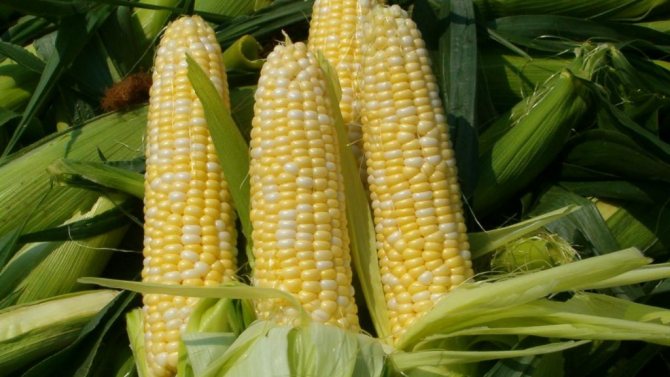

INTERESTING! It is best to remove corn in the evening or in the morning, as the corn is sweeter at lower temperatures.
The hardening and biological maturation of seeds should not be allowed. They are brought only to the milky-wax ripeness: the grains become full-bodied, full, shiny, smooth, elastic, but remain juicy and moderately soft, acquire the color typical of the variety. The pistil filaments darken and die off, the covers of the cobs begin to dry out from the edges.
Expert opinion
Stanislav Pavlovich
Gardener with 17 years of experience and our expert
Ask a Question
IMPORTANT! Overripe grains of sweet corn become dull, hard, do not emit juice when pressed. They do not soften well even after prolonged cooking.
For transportation and storage, cover leaves are left on sweet cobs or peeled vegetables are wrapped in cling film. In a cool, not too damp room (or in the refrigerator), fresh crops are stored for 6-10 days.
INTERESTING! For long-term storage, raw or boiled corn is frozen with whole cobs or grain.
Sugar corn: growing seedlings
As mentioned, corn is a later plant. And even from the early varieties of the harvest, you have to wait a long time - at least 2-3 months. Therefore, many summer residents grow this culture in a seedling way. At the same time, gardeners use approximately the following planting technology:
- A special substrate is poured into the boxes, made up of garden soil and compost in a 1x1 ratio.
- The seeds are pre-germinated at room temperature in moist foil paper.
- They are planted to a depth of 3-4 cm.


Early varieties of sugar corn are planted for seedlings in late April - early May - about 25 days before being carried into open ground. Since corn does not tolerate transplanting very well, special peat glasses can be used instead of boxes. In any case, when transporting to open ground, it is worthwhile to carefully ensure that the roots of the plants are not damaged. If you do not need to get a very early harvest, it is better to sow the corn directly into the soil.
Growing features
When the first shoots appear, the main task of gardeners is to regularly loosen the soil and remove weeds. Corn is famous for its developed multi-tiered root system, which requires free space and an abundance of nutrients.
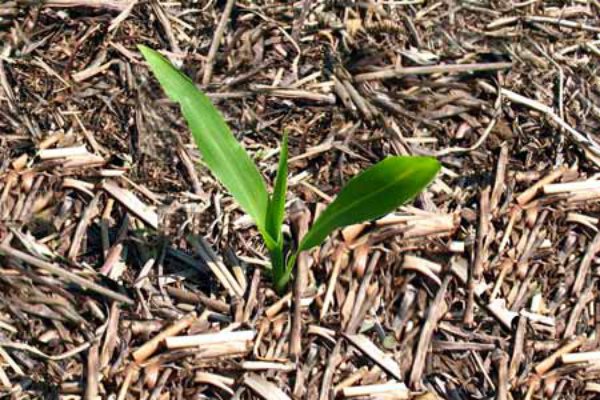

It is also important to apply fertilizers in a timely manner: at the stage of 5-8 leaves - potassium salt and nitrate; on the eve of flowering - phosphorus and potassium; during fruiting - superphosphate, phosphorus and potassium.
For the rest, the main thing is to monitor the condition of the leaves so as not to miss the time of the next watering and subsequent loosening of the soil.
What fertilizers are needed for sweet corn during growth
Like any other garden crop, corn needs additional feeding from time to time. This plant is very large and needs a lot of nutrients. Feed sweet corn at least twice a season. When planting, as already mentioned, it is useful to apply organic and phosphorus fertilizers to the furrow. Corn also responds very well to products containing a large amount of zinc. This can be, for example, PMU-7.
The second time, the plants are fertilized two weeks after planting. In this case, it is better to use products containing a lot of nitrogen.
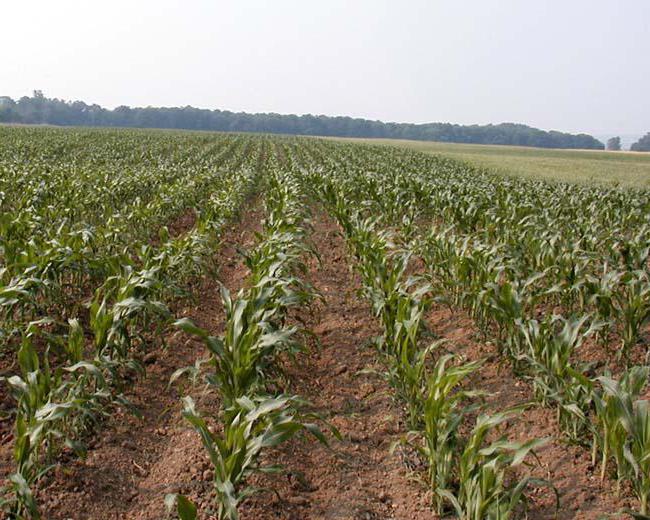

What fertilizers are needed for sweet corn during growth, they learn from the condition of the bushes themselves. Various kinds of negative changes may indicate a lack of certain elements in the soil. So, for example, a lack of nitrogen will manifest itself in yellowing and drying of the leaves (subject to periodic watering). Potassium starvation is manifested by the suspension of development and the appearance of "burns" on the tips of the leaves. If there is a lack of phosphorus, the green tissue of corn will begin to turn red.
The benefits and harms of sweet corn
The rich, well-balanced composition of sweet corn determines a number of its beneficial qualities.The cob contains a whole complex of vitamin and mineral components that allow you to establish and improve the functioning of many body systems. The presence of a large amount of fiber has a beneficial effect on the work of the digestive tract, improves digestion, and speeds up metabolic processes.
Learn more about the corn diet.
It has a laxative effect, improves gastrointestinal motility, cleanses the body of toxins and harmful substances. Due to the high content of starchy components, the vegetable is directly involved in the formation of muscle and nervous tissue. Vitamin C helps to strengthen the immune system, increase the protective functions of the body, the group of B vitamins - normalizes the state of the nervous system, activates the brain, improves memory, relieves nervousness, insomnia and depression.
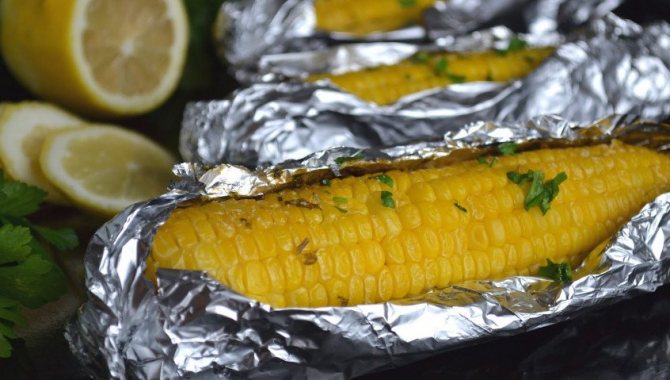

Regular consumption of corn allows women to establish hormonal levels, to endure menopause easier, and for men to improve their sex life, increase potency, and normalize the stable work of the urogenital organs. In addition, corn, due to its rich mineral composition, has an excellent effect on teeth, strengthens the gums, and relieves bleeding. However, corn, like other vegetables, is not able to have the absolute benefits.
- Contraindications to the use of the product are:
- peptic ulcer, gastritis with high acidity, other erosive damage to the intestinal mucosa during an exacerbation;
- increased blood clotting, thrombophlebitis;
- reduced weight. Since corn is a nutritious product and quickly causes a feeling of fullness, it is not recommended to use it with a small body weight, so as not to reduce the use of other products;
- individual intolerance to the vegetable.
In addition to the benefits for humans, this cereal is widely used as a raw material for the production of medicines, the manufacture of corn oil.
How to water
Corn requires quite a lot of water during its growth. It is not recommended to allow the soil under this plant to dry out. Otherwise, the corn will stop growing and its ears will not develop. It is also impossible to transfuse this culture. This can lead to overconsolidation of the soil. Without oxygen, the roots of the plant will cease to grow well, and the bushes that have received less nutrients will significantly reduce the yield.
In particular, sweet corn, the cultivation of which is a relatively simple matter, needs moisture for the formation of cobs. At this time, you need to water it more often. If the plant has enough water, it will certainly delight the owners with juicy and sweet grains.
How to care for Dutch corn
Dutch sweet corn hybrids are genetically tolerant to various stresses, so they do not require much gardener attention. But even minimal care leads to an acceleration of the ripening of the ears and an increase in yield. Hybrids tie well, but it is still useful to periodically shake the bushes during the flowering phase for better pollination.
See also How to shell corn at home - we make a homemade shell shell
Loosening and mulching the soil
Immediately after sowing, the soil is lightly rolled and mulched so that the soil crust does not interfere with the seedlings. The first (shallow) loosening of the plantings is carried out when the young corn has 3-5 leaves. When growing up to 70 cm, the bushes are slightly huddled and mulched with light compost.


Watering and feeding
The greatest need for moisture is in corn:
- in the germination phase;
- when throwing brooms (male flowers);
- 15 days after the release of the pistillate threads from the female ovaries;
- when forming grains;
- in the initial stage of fruit pouring.
You can grow sweet corn without watering if it rains intermittently. When the soil dries up, it is advisable to water the beds, soaking the soil to a depth of at least 30 cm.
It has been noticed that top dressing increases the yield of sweet corn by 1.3-2 times.
Fertilizer Irrigation Schedule:
- When pushing male brooms, nitrogen and potassium (aqueous solution of manure 1:10 + ash or 20 g of Urea + 15 g of potassium sulfate in a bucket of water).
- When pistillate threads come out, nitrogen and phosphorus (water infusion of bird droppings 1:20 or 20 g of Ammophos per bucket of water).
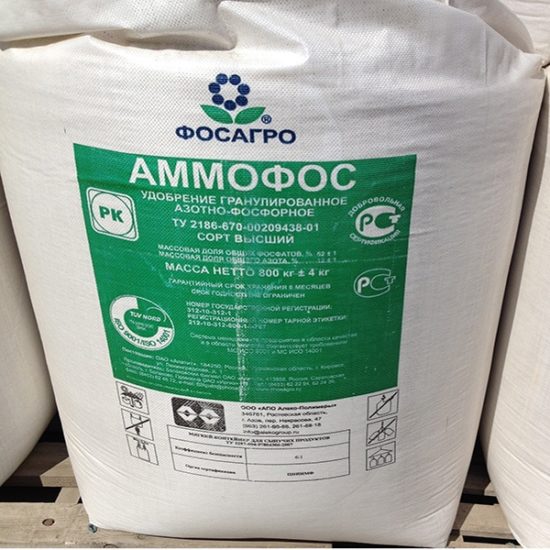

A bucket of nutrient solution is distributed over 2 square meters. m of the root zone.
Expert opinion
Stanislav Pavlovich
Gardener with 17 years of experience and our expert
Ask a Question
IMPORTANT! Root dressing is given only on wet ground.
Protection against diseases and pests
Dutch hybrid corn is quite disease resistant. However, to prevent root and stem rot, the soil can be shed with a biofungicide (Sporobacterin, Trichocin, Trichoderma Veride) 5 days before sowing.
Insects such as wireworms damage the corn roots. On the plots massively populated with these larvae, pesticides containing the chemical diazinon - Provotox, Zemlin, Pochin - are introduced into the ground before sowing corn.
Biological pesticides are used against corn aphids and stalk moth caterpillars (Fitoverm, Iskra Bio).
Ripening signs
The corn must be harvested on time. The caryopses of unripe cobs are not very tasty and do not differ in juiciness. Overexposed fruits become too hard and dry. Maize is harvested usually 20-25 days after the beginning of flowering - in the phase of milky ripeness. During this period, the fruits of this plant contain the most sugars. The main signs of maturation are:
- drying of the edges of the upper wrappers;
- darkening of pistil filaments at the top of the cob;
- tight adherence to each other of the weevils;
- uniform color of all fruits.
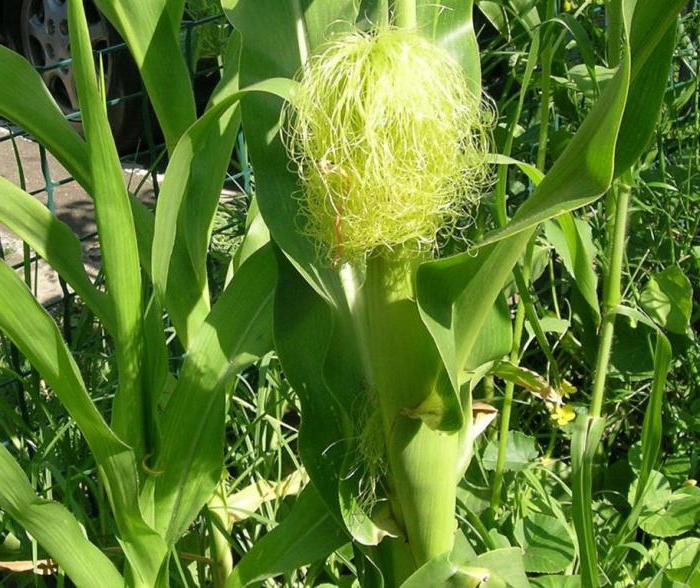

When pressed on ripe kernels, their shell bursts, and the milk-sugar liquid flows out.
The corn is usually harvested for several weeks in a row. The ears on the bushes are not formed at the same time. The harvested crop should be immediately processed - boiled or preserved. The fact is that when stored on the cob, the percentage of sugar content decreases very quickly. It is worth harvesting corn early in the morning. It is at this time that the most sugar accumulates in the caryopses. If the corn does have to be stored, it is best to freeze it first.
Growing technology
The technology of growing varieties of sweet corn is practically no different from growing fodder cereals. However, in order to obtain a high, high-quality harvest, it is recommended to follow several important rules for planting and further care.
Planting and care rules in the open field
To grow a sugar vegetable, it is necessary to choose nutritious, loose soils, with an acidity level of at least 5. Since corn is a moisture-loving crop, experts advise to loosen the soil in autumn so that enough moisture will accumulate in it during the winter. In the spring, immediately before planting, the land should be cultivated with a cultivator, mineral and organic fertilizing should be applied, in particular, humus or compost.
When planting grains, you need to adhere to several important principles:
- sowing work should be carried out no earlier than mid-May, when the earth is well warmed up, and the likelihood of night frosts is minimized;
- Before sowing, it is recommended to carefully prepare the seed material: put it in the sun for 4–5 days, then soak it for one hour in cool water. Such events will allow to “harden” the seeds and intensify their growth;
- seeds should be sown according to the scheme 60x30 cm, placing 2-3 grains in one hole, deepening them into the soil by 5 cm;
- after the emergence of seedlings, they should be thinned out, leaving one of the largest and strongest plants;
- the emerging seedlings must be covered with a film to protect them from possible night frosts.
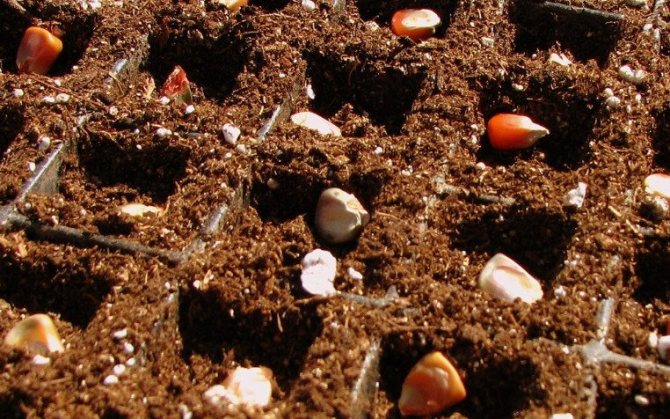

Further care of seedlings is traditional and consists in the implementation of such procedures:
- regular loosening of the soil;
- weed cleaning;
- moistening crops and watering;
- processing of crops from pests.
It is especially important to pay attention to the moistening of corn during the ripening of the cobs, since the taste of the fruits, their juiciness and tenderness will directly depend on the degree of soil moisture. Experts recommend the need for moisture control according to the condition of the soil and categorically not to allow it to completely dry out.
One plant on average needs 2-3 liters of water, which should not be cold. After 5-6 full-fledged leaves are formed on the stems, fertilizers should be applied, for which potassium-based products will be the best option.
Important! Sweet corn has a negative attitude towards transplanting, therefore, experts advise growing the plant in a seedling method if absolutely necessary, carefully observing that the root processes are not damaged.
If the leaves turn yellow or lose their color, you need to feed the plant with nitrogen complexes. The second top dressing is applied at the beginning of the peduncle formation. Fertilizers should be applied in the form of solutions, combining the procedure with watering. Also, experts advise to cut off lateral shoots on the culture, since they inhibit the development and growth of the ears.
Video: rules for planting corn
Drip irrigation
Since the root system of sweet corn is poorly developed in comparison with fodder, it needs constant moist soil and nutrition. That is why in the southern steppe regions with a dry, hot climate, experts advise cultivating a crop on continuous drip irrigation, which makes it possible to distribute a certain amount of water evenly directly under the root, thereby contributing to the full growth and development of the plant.
To ensure the proper level of moisture per hectare, about 3500-8000 cubic meters will be required. water, depending on weather conditions. It is necessary to carry out drip irrigation at night or during a period of not too high solar activity in order to avoid excessive drying of the soil due to moisture evaporation. One of the main advantages of drip irrigation is the timeliness of applying the necessary fertilizers during critical periods for the plant.


For example, during the growing season, corn needs potassium and nitrogen fertilization, at the beginning of its growth and during the formation of grains - in phosphorus. Drip irrigation allows you to instantly feed the corn with the appropriate preparations. The competent organization of this type of irrigation contributes to high crop yields and, as a result, high profitability of the event.
How to Fight Sweet Corn Disease
Subject to the processes of crop rotation, the use of processed seed material, timely weeding and sanitization of corn, diseases and pests are not terrible.
However, if one of these points is violated, the plant may be subject to various ailments, among which the most common are:
- Gray rot... The stalk and ears of the culture are affected, spots of a dark shade are formed on them, as a result of which their development slows down. Unfortunately, it is impossible to cure the plant in this case, it must be burned. The next year, the place for planting corn needs to be changed or the soil should be shed with fungicidal preparations.
- Fusarium... The disease is fungal in nature and manifests itself in the form of a light bloom on the fruit. As a result of the action of the fungus, the ears begin to rot. Diseased plants must be removed and burned.
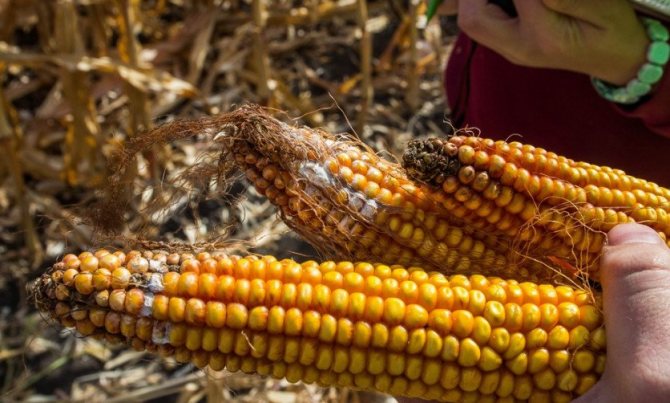

- Rust... A similar fungal disease is easily recognized by red spots that appear on the underside of the leaf plate. Disease can be prevented by treating seedlings with fungicides.


- Helminthosporiosis... It appears as brown spots on the underside and then on the upper side of the leaf.On the heads of cabbage between the grains, a raid of dark brown color is formed. When the root system is damaged, the plant withers and dies.
For the prevention of ailments, experts advise to regularly examine the plant for lesions - rot and dryness of foliage, the presence of parasites. You should also treat the culture with modern fungicidal preparations.
When to harvest sweet corn
Harvesting sweet corn should be carried out when it is at the stage of milky ripeness, because it is then that the taste of its grains is most intense, sweet and delicate. During this period, the cobs of the plant must be collected, and the grains must be used for processing - pickled, boiled, and preserved. To establish the exact time of harvest, experts recommend counting 20-25 days from the end of the flowering period of the crop.
Important! Plucked heads of cabbage need to be processed immediately, because after 5-6 hours they lose their "sugar" value by half.
In addition, the readiness of a plant for collection can be determined by the following signs:
- the top layer of wrapping sheets from above begins to dry out along the edges and tightly wraps around the cob;
- corn fibers acquire a brown color, but do not completely dry out yet;
- the grains in the head of cabbage adhere tightly to each other;
- on all grains, including the top ones, there is a uniform yellow color;
- the tops of the seeds are dense, round, elastic, without wrinkles.


In most cases, the harvest period is in early August, but with high temperatures throughout the summer, corn can ripen 2-3 weeks earlier. It is recommended to pick the cobs in the morning, when they are filled with moisture and a high level of polysaccharides as much as possible. As a rule, the harvested crop is used fresh, pickled for further use in various recipes for the winter, and canned.
What is the yield of corn per hectare
With high-quality agricultural technology and compliance with all the rules for caring for corn from one hectare of land in one season, it is possible to collect from 45 to 70 centners of early ripening products. Varieties with an average ripening period are able to please with an average yield of up to 50 centners from 1 hectare of soil.
Did you know? Under the influence of sunlight, the percentage of sugar content in the grains decreases, but quickly recovers at night.
Sweet corn is one of the most favorite foods in the summer, which adults and children alike adore to feast on. The plant has a high nutritional value, contains a number of useful substances that contribute to the normalization of the functioning of many body systems. Consuming corn regularly, you can not only get a pleasant taste, but also heal your body.
Diseases and pests
Corn is quite resistant to infection with various kinds of fungi and bacteria. However, sometimes this plant still gets sick. The most common problem is seedling mold. This usually happens when the seeds are planted too early. Cold air and soil, subject to high humidity, provoke the development of penicilli fungi. They fight this disease with all sorts of fungicides.
Also sometimes sweet corn is affected by helminthosporiosis. In this case, leaves, internodes, roots, and sometimes the cobs may suffer. This disease usually manifests itself in the second half of summer in the form of large brown spots. For its prevention, it is imperative to burn post-harvest corn residues.
Waxy maize
This group includes varieties of corn, the starch of which has only one component in its composition - amylopectin. Starch of other varieties consists of another element - amylose. So, due to the absence of monosaccharides, the wax culture is absorbed more slowly, therefore, it increases efficiency and reduces blood sugar. It follows from this that it is especially useful for diabetics.
Popular waxy maize varieties are:
- Early pink glow... High-yielding super-early variety - ripens in 60 days. The plant grows 1.4 m long, has small pyramidal ears (up to 14 cm). The grains are distinguished by unusual colors - they are pink and lilac. As it ripens, the corn becomes sweet, so it tastes good when cooked.
- White Dacota... This is early maturing corn - the growing season is about 80 days. The plant grows tall - up to 1.8 cm. The ears are up to 14 cm long and pyramidal in shape. The grains are small and white. This variety is suitable for freezing, boiling and baking.
- Black Waxy Corn... Refers to mid-season varieties - it will take about 3 months to get ripe grain. The stems grow up to 1.7 m. The cobs can be small or medium in size - from 10 to 20 cm. The grains acquire an unusual color - emerald-black. The vegetable is suitable for cooking.
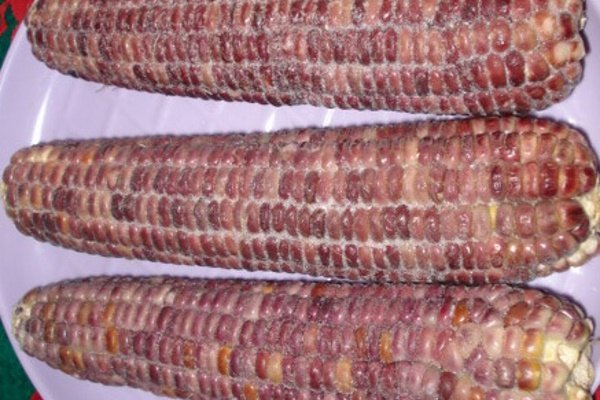

variety Early pink glow


variety White Dakota (White Dacota)


variety Black Waxy Corn
Interestingly, waxy maize was first discovered in China in 1909.
Reviews of gardeners
Of course, corn is inferior in popularity among summer residents to main crops, such as, for example, cucumbers or tomatoes. Not all gardeners grow it. However, there are also devoted followers of this wonderful plant. Most lovers of this culture explain their love for it primarily by the opportunity to diversify the family table. After all, boiled cobs are really very tasty and, moreover, contain a lot of substances useful for the body.
Sweet corn also earned good reviews for the fact that with its help you can create special growth conditions, for example, for the same cucumbers. Planting corn beds with this crop allows you to create a special "greenhouse" microclimate. Thus, in the vicinity of this plant, cucumbers develop much faster.
Beneficial features
Sweet and tasty corn was once named the Queen of the Fields. With this title, a plant can be awarded not only for its sweetness, but also for its useful qualities.
Due to the high content of nutrients and trace elements in corn, it must be included in the diet in the following cases:
- Diseases of the eyes. Corn grains contain two of the most important carotenoids - lutein and zeaxanthin, the so-called macular pigments that prevent retinal damage and have an extremely positive effect on vision in general.
- Prevention of anemia. Lack of iron in the body makes it difficult for the body to form red blood cells. A high percentage of iron in corn (2.7 mg per 100 g) will help prevent possible iron deficiency.
- Cancer prevention. Carotenoids are difficult to break down by the human body, so cooked sweet corn is much healthier than raw corn, as the absorption of antioxidants becomes easier and faster.
- A source of fiber. Fiber (and there are almost 7 grams per 100 grams in corn) helps to lower cholesterol levels, and also greatly contributes to the digestive process.
- Weight loss. Corn is great for nutrition during weight loss, as it contains a large amount of nutrients and trace elements, while the carbohydrates that make up corn are complex (the body will spend more energy to process them than it will receive with them).
- Healthy eating. The phytonutrients and biologically active substances contained in corn kernels have made corn a valuable component of a healthy diet. The enzymes found in corn (phytic and ferulic acids, anthocyanins) are very beneficial for health.
- Gluten free. The most important product quality for people with celiac disease. Corn flour is used to prepare bakery and flour products for a gluten-free diet.
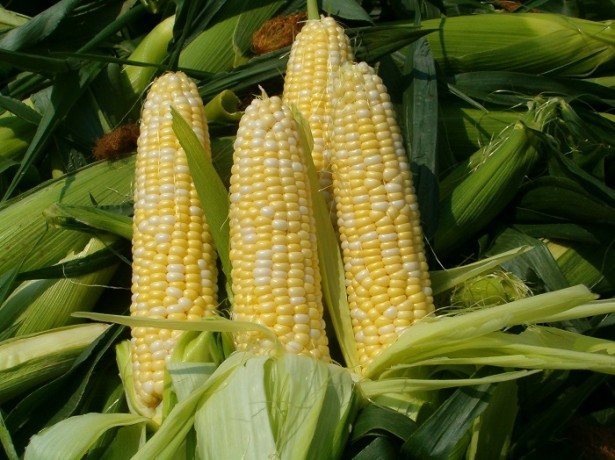

Sugar corn
Delicious corn flavors Spirit F1
There are a wide variety of recipes that can be used with any variety of sweet corn, including Spirit F1.
A simple recipe for cooking corn in a double boiler
The ears are peeled from leaves, washed with cool water and dried with a towel. Water is poured into a bowl, and the cobs themselves are placed for steaming. The lid is closed and the time is set to 35 minutes. After the finished corn has cooled, the ears are greased with butter, sprinkled with salt and served.
Corn pancakes
Cooking requires cornmeal and canned sweet corn. The water is drained from the canned grains. Kefir is added to a separate bowl, flour is diluted in it, salt, sugar and soda are added. All ingredients are thoroughly mixed. Canned corn grains are poured into the resulting dough and frying is started. Measure out a small portion of the dough with a spoon and place in the pan.
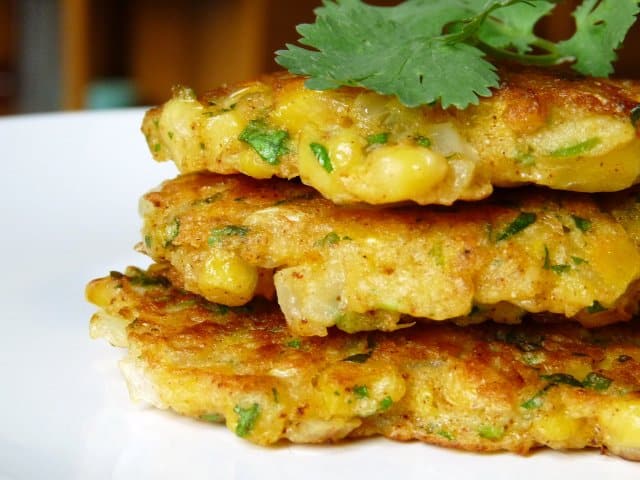

Corn soup
Finely chop the peeled onions, chop the peeled carrots and celery using a grater. Cut potatoes and zucchini into small cubes.
Melted butter (20 g) and vegetable oil (25 ml) in a saucepan, and then add chopped onions, frying until golden brown. After that, add carrots and celery, and after a couple of minutes potatoes. Vegetables are poured with a liter of boiled water.
5 minutes after boiling, zucchini and canned corn are added to the vegetables along with the liquid in the jar. After that, cook for another 10 minutes. At the end of cooking, add salt, spices and melted cheese.
It is recommended to grind the finished soup in a blender until smooth. You can decorate the finished dish with herbs.
Salad with corn and mushrooms
Boil chicken fillet in salted water. The mushrooms are washed and cut into small cubes. Fry chopped onions in warmed vegetable oil until golden brown, after which mushroom cubes are added. After 15 minutes of frying, salt and pepper the onions and mushrooms.
Hard cheese is chopped on a grater, water is drained from canned corn, chicken fillet is taken out of the broth and allowed to cool. After that, cut the fillet and canned pineapple into small cubes.
Then they begin to form the salad. The first layer in a salad bowl is spread the chicken, then the onion with mushrooms. Put corn, chopped pineapple on the mushrooms and grease everything with mayonnaise. From above, evenly cover everything with cheese.
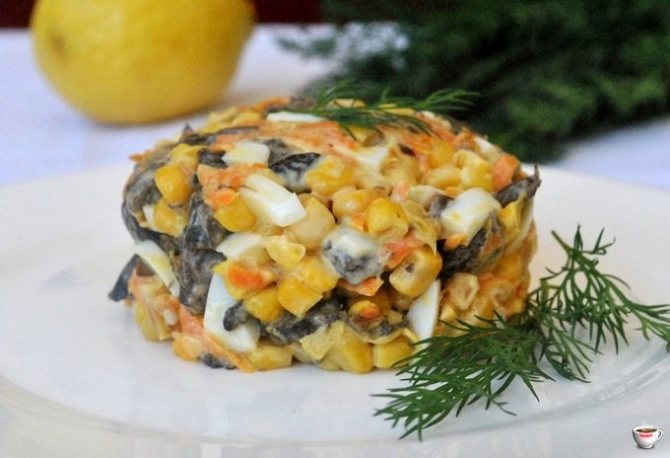

Harvest
The ears are suitable for harvesting at the stage of milky-wax maturity. It is important not to skip this period, otherwise the grains will become coarse, hard and lose their juiciness. There are several signs that determine the ripeness of corn:
- You can determine the ripeness of the cob by the corn silk. It turns from emerald green to yellow-brown.
- Another sign of ripeness is the color of the grains. They are colored white or yellow, depending on the selected variety. In this case, the grains adhere tightly to each other, and the shell is easily pierced.
- The upper wrapping leaves of the head become dry and begin to turn yellow.


Most often, the harvest of corn begins to be harvested in early August. Harvesting is best done early in the morning.
Judging by the reviews, corn Lakomka Belogorya won one of the first places among experienced vegetable growers. It is noted that it is easy to care for corn plantings during cultivation, almost all sown seeds sprout together and on time. The first ears can be eaten after 90 days.
On one stem, 150 cm high, up to 4 ears can form. Vegetable growers also note the high yield of the variety, the plant does not require frequent watering, the grains of the harvested ears retain their juiciness and sweetness for a long time.
Care
The entire period of growing sweet corn, you need to follow some recommendations. The first time after planting, the plant grows slowly.During this time, he will benefit from loosening and weeding. Agricultural rules:
- Corn requires abundant watering. The size of the ears and the sweetness of the grains directly depend on the correct watering regime. Especially a lot of moisture is required during seed germination and ear formation.
- Loosening of the soil is carried out after each watering and after rain. The higher the plant becomes, the shallower the soil loosening depth. This will reduce the risk of damage to the adventitious roots.
- During the flowering period, an additional pollination procedure can be carried out. To do this, the male flowers are plucked (they are at the top of the stem) and shake them over flowering cobs (there are female flowers here).
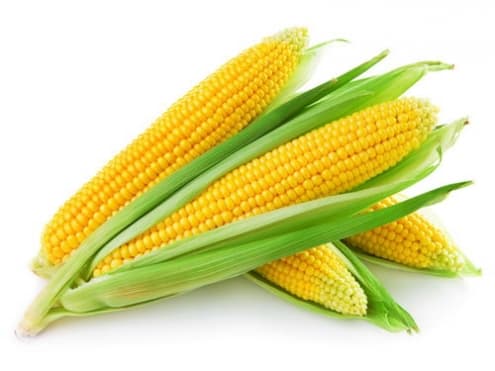

- To accelerate the growth of the plant and the formation of the cob, pinching is carried out. All lateral shoots are cut off.
- Weeds should not be allowed to grow, so weeding is carried out in a timely manner.
- Carry out preventive treatments to protect against pests and diseases. At the first sign of their appearance, measures must be taken to preserve the harvest.
Fertilization takes a special place. Corn responds well to compost and humus. The first top dressing can be done when 5–6 leaves develop on the plant. After unfolding the fifth leaf, potash fertilizers are applied. A liquid solution of ammonium nitrate, superphosphate can be added to the aisles.
If the leaves turn pale green, yellow streaks have appeared, it may be necessary to add nitrogen components. If the edges of the leaves begin to turn yellow and dry, you need to add potassium.

